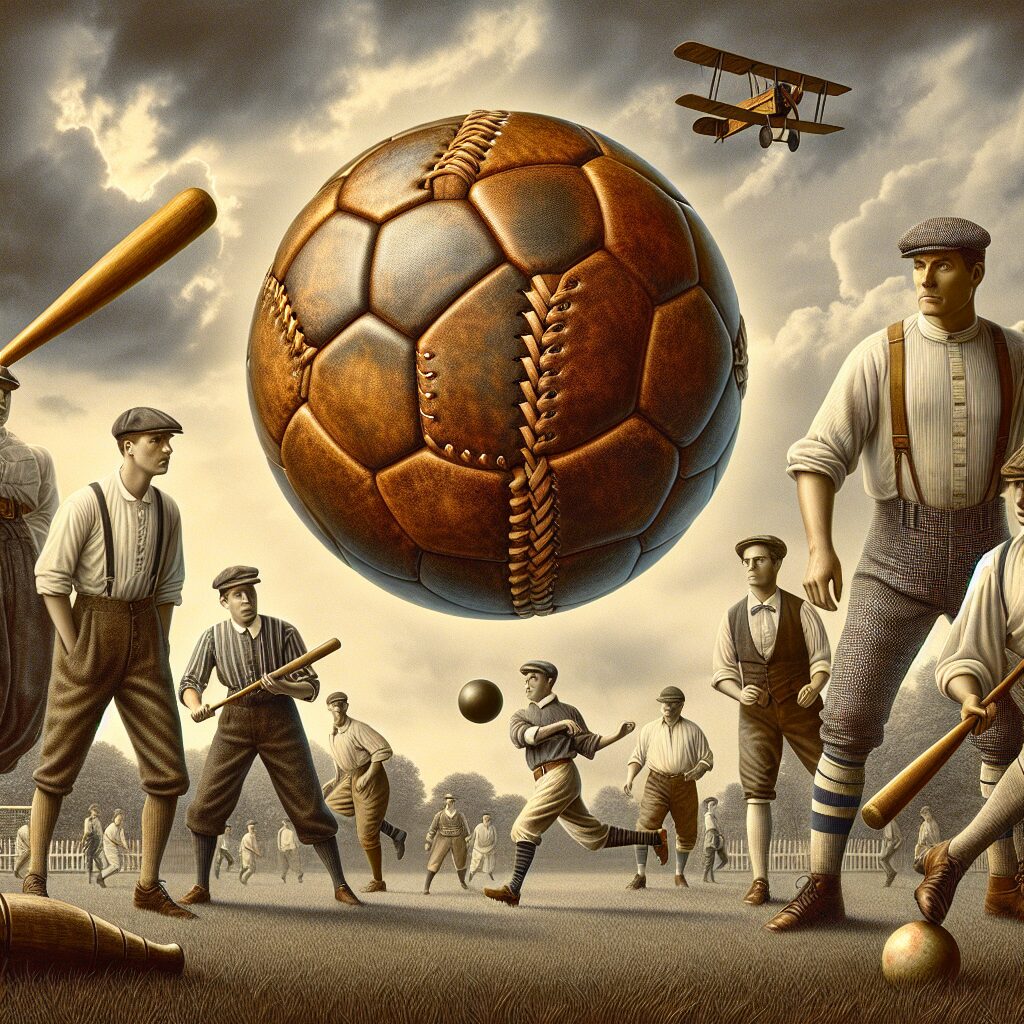The 19th century witnessed a remarkable transformation in the world of ball sports. From the advent of modern rules to the establishment of professional leagues, this era laid the foundation for the organized and globally acclaimed sports we know today. One significant impact of this century of change was the standardization of rules across different regions, enabling fair competition and fostering the growth of these sports. Moreover, technological advancements like the introduction of rubber and synthetic materials led to significant improvements in equipment, enhancing the quality of gameplay and player safety.
As we delve deeper into the topic of 19th-Century Ball Sports: A Century of Change, let us explore the key takeaways to gain a better understanding of how this transformative era shaped the sports we love today. Firstly, we will uncover how the establishment of national or international competitions paved the way for the widespread popularity of ball sports. Secondly, we will delve into the social impact of these sports, examining their role in fostering community and sportsmanship. Lastly, we will discuss the enduring influence of 19th-century ball sports on contemporary practices, highlighting the lasting legacies of this formative era. Stay tuned to uncover the fascinating details that will uncover the roots of your favorite ball sports.
Key Takeaways
1. The 19th century was a significant period for the development and evolution of ball sports, witnessing numerous changes that laid the foundation for modern sports.
2. Traditional ball games played during this era included cricket, baseball, soccer, and rugby, which all underwent remarkable transformations and rule adaptations.
3. The introduction of standardized rules, such as the Laws of Cricket and the Cambridge Rules of Association Football, played a pivotal role in providing structure and uniformity to these sports.
4. Industrialization and urbanization profoundly impacted ball sports, as they became more widely accessible and increasingly ingrained in society, attracting larger spectator crowds and fostering competitive leagues.
5. The 19th century also witnessed the emergence of a global perspective on ball sports, as they began to transcend national boundaries through international competitions and cultural exchanges.
How Did 19th-Century Ball Sports Change Over the Century?
Early Origins of Ball Sports
In the early 19th century, ball sports began to gain popularity as various games involving balls emerged. These sports were often played in open fields or streets, providing entertainment for both participants and spectators.
The Rise of Organized Sports
As the century progressed, ball sports started to transform into organized games with standardized rules and regulations. This shift allowed for more structured matches and fostered the development of sports clubs and associations.
1. The Role of Equipment
One notable aspect of the changes in 19th-century ball sports was the evolution of equipment. Early games relied on simple balls made from materials like linen or animal bladders. However, advancements in technology led to the introduction of more durable and standardized balls, making gameplay more consistent.
2. Changing Rules and Strategies
The rules and strategies of ball sports underwent significant changes throughout the 19th century. As sports became more organized, committees and associations were formed to establish consistent rules across different regions and clubs. These standardized rules enhanced fair play, increased competitiveness, and facilitated the growth of the sports.
3. Emergence of New Ball Sports
During this century, several new ball sports emerged and gained popularity. Sports such as baseball, basketball, and volleyball were invented, each bringing their own unique rules and elements of play. These novel sports added diversity to the sporting landscape and opened up new avenues for competition.
4. Professionalization and Commercialization
As the century neared its end, ball sports started to transition toward professionalization and commercialization. The growing interest from both participants and spectators led to the establishment of leagues, professional teams, and the organization of major tournaments. This shift significantly impacted the popularity and visibility of ball sports.
5. Social and Cultural Impact
Throughout the 19th century, ball sports played a crucial role in shaping social interactions and cultural norms. Sports became a means of establishing social hierarchies, fostering national pride, and promoting a sense of community. The increased participation and acceptance of ball sports reflected broader societal changes during this period.
Conclusion
As the 19th century progressed, ball sports underwent a remarkable transformation. From humble origins, they evolved into organized, regulated games with standardized equipment and rules. The emergence of new sports and the shift towards professionalization and commercialization further fueled their growth. These changes not only impacted the sports themselves but also influenced social dynamics and cultural values.
- What were the main factors that influenced the changes in 19th-century ball sports?
- What were the key developments in equipment during this period?
- How did the establishment of standardized rules and regulations impact the growth of ball sports?
- Which new ball sports emerged during the 19th century, and what were their unique characteristics?
- What were the social and cultural effects of the changes in ball sports during this period?
Frequently Asked Questions
1. What were the most popular ball sports in the 19th century?
The 19th century witnessed the rise of several popular ball sports, including baseball, football (soccer), cricket, tennis, and rugby. These sports gained immense popularity and played a significant role in shaping the sports culture of that era.
2. How did 19th-century ball sports differ from modern-day sports?
19th-century ball sports had several key differences compared to their modern counterparts. The rules and regulations were often less standardized and evolved over time. Additionally, equipment, playing fields, and strategies varied greatly from what we see today.
3. Did women participate in 19th-century ball sports?
Although limited, women did participate in 19th-century ball sports. However, societal norms and restrictions often barred them from competing at the same level as men. Women’s participation gradually increased throughout the century, setting the stage for their greater role in sports in the years to come.
4. Were there any regional variations in ball sports during this time?
Definitely! Different regions had their preferred ball sports and often developed unique variations. For instance, while baseball gained popularity in the United States, cricket remained prevalent in England. These regional variations contributed to the diverse landscape of 19th-century ball sports.
5. How did the industrial revolution impact 19th-century ball sports?
The industrial revolution brought about significant changes in 19th-century ball sports. It led to the mass production of sports equipment, making them more accessible and affordable. Improved transportation systems and urbanization also facilitated the growth and spread of these sports.
6. Was gambling widespread in 19th-century ball sports?
Yes, gambling was prevalent in 19th-century ball sports, especially in horse racing, cricket, and boxing. It was not uncommon for spectators and participants to place bets on these sports, adding an element of excitement and financial stakes to the events.
7. How did racial segregation affect 19th-century ball sports?
Racial segregation played a significant role in 19th-century ball sports, particularly in the United States. African Americans and other racial minorities were often excluded from mainstream sports. However, they formed their own leagues and teams, laying the foundation for future integration in sports.
8. What were the major advancements in 19th-century ball sports?
The 19th century witnessed several advancements in ball sports. The introduction of standardized rules, the use of professional players, the establishment of formal leagues, and the invention of modern sports equipment were some of the notable advancements that shaped the future of these sports.
9. How did media coverage impact 19th-century ball sports?
Media coverage played a crucial role in popularizing 19th-century ball sports. Newspapers started reporting on matches, providing live updates and analysis, which increased the sports’ visibility and interest among the general population.
10. What is the legacy of 19th-century ball sports?
The legacy of 19th-century ball sports continues to resonate in modern sports culture. The sports that gained popularity during this time laid the foundation for their global reach and established a sense of tradition. The developments and challenges faced in that century continue to shape the evolution of sports today.
Final Thoughts: 19th-Century Ball Sports: A Century of Change
The 19th century stands out as a pivotal period in the evolution of ball sports. From the widespread popularity of baseball and cricket to the gradual inclusion of women and racial minorities, this century witnessed significant changes and advancements. The industrial revolution, regional variations, and media coverage played influential roles in shaping the sports landscape of that time.
As we reflect on the legacy of 19th-century ball sports, we must acknowledge the pioneers who laid the foundation for the sports we know and love today. Their contributions and perseverance have formed a rich history that continues to inspire athletes and sports enthusiasts alike. The century of change in 19th-century ball sports serves as a reminder of the transformative power of sports and its ability to unite people across time and cultures.




